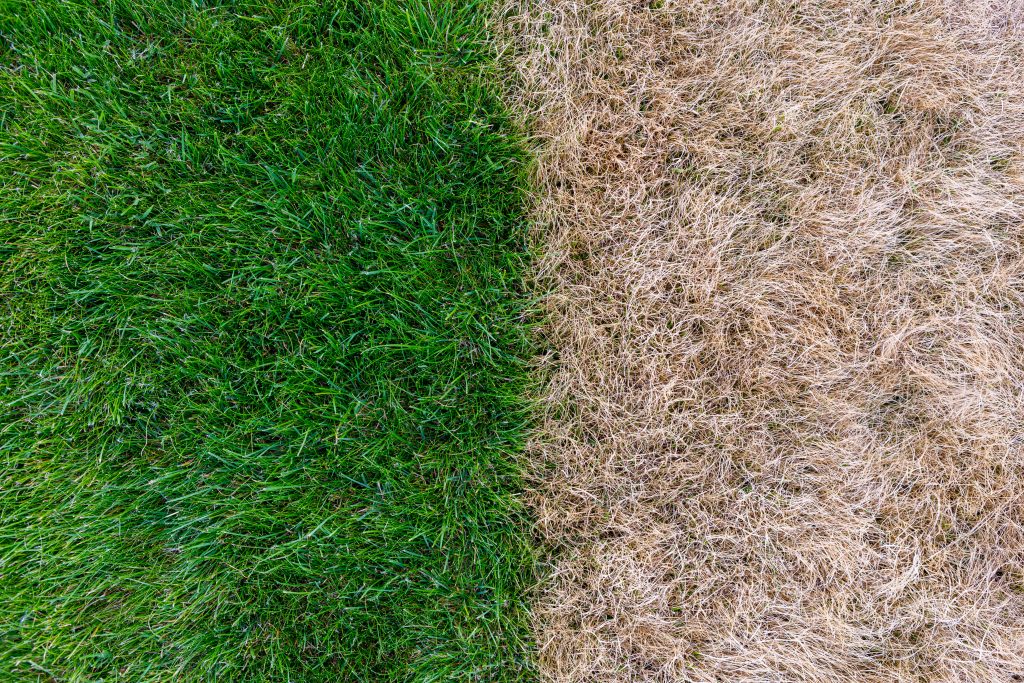As we bid farewell to spring and welcome the warm embrace of summer, it’s time to turn our attention to our lawns. The lush green that’s become the pride of your backyard didn’t get that way by chance, and keeping it that way throughout the summer requires a bit of work, but don’t worry—we’re here to help you through it!
Mowing Your Lawn the Right Way
One of the most crucial aspects of lawn maintenance during the summer months is mowing. Though it may seem like a simple task, the way you mow your lawn can significantly impact its health and overall appearance.
Best Mowing Techniques for Summer
In summer, lawns can face stress due to increased temperatures and reduced water availability. Start with a strong base using our Lawn Turf.
To help your lawn cope, it’s advisable to mow it a bit higher than you would in other seasons. By leaving the grass slightly longer, about 2.5 to 3 inches, you allow it to develop deeper roots and better withstand dry conditions. Longer grass also shades the soil, reducing water evaporation and suppressing weed growth.
Make sure that your mower blades are sharp. Dull blades can tear the grass, leading to jagged edges, which can cause the grass to lose more water and be more susceptible to disease. Aim for a clean cut that doesn’t stress the grass.
Ideal Mowing Height
The ideal mowing height can vary based on the type of grass you have, but as a general rule, never remove more than one-third of the grass blade at a time.
Cutting the grass too short, also known as “scalping,” can stress it and make it more susceptible to pests and diseases.
Best Time to Mow During Summer
Timing is another essential aspect of mowing.
The best time to mow your lawn in the summer is early in the morning or in the evening when the sun is not at its peak. Mowing at midday can put the grass under additional stress from the heat.
And remember, during especially hot and dry periods, it’s beneficial to reduce the frequency of mowing. The longer grass blades can provide shade to the roots and help retain moisture.

Watering Your Lawn Properly
In the heat of summer, watering becomes a critical aspect of lawn care. However, it’s not just about making sure your lawn gets water—it’s about watering it the right way.
How Often to Water Your Lawn
Knowing how much water to apply to your lawn is just as important as knowing when to water it.
As a general rule, most lawns need about 1 to 1.5 inches of water per week, either from rainfall or irrigation. This amount may need to be increased during the hotter and drier summer months if your area isn’t receiving adequate rainfall.
It’s better to water deeply and infrequently, rather than shallowly and frequently. A deep soaking once or twice a week is more beneficial as it allows the water to penetrate deeper into the soil, promoting deeper root growth and making the grass more drought-resistant.
However, be careful not to overwater. Too much water can lead to problems like root rot and fungal diseases. If water starts to puddle or run off the lawn, it’s a sign that you’re applying too much water too quickly. In this case, try watering for shorter periods more frequently to give the water time to soak in.
When to Water Your Lawn
Timing is crucial when it comes to watering your lawn, especially during the scorching summer months.
The ideal time to water your lawn is in the early morning or late evening when temperatures are cooler.
This timing reduces the amount of water lost to evaporation and allows the water to penetrate deeper into the soil, ensuring it reaches the roots of the grass.
TOP TIP
During particularly dry periods, you may need to adjust your watering routine. Watering should still be done in the cooler parts of the day, but you may need to increase the frequency depending on how quickly the soil dries out.
If you’ve recently laid new turf, it will require special attention. Newly laid turf should be watered thoroughly every evening to encourage it to root into the soil and prevent it from drying out.

Watering New Turf
If you’ve recently laid new turf, it will require special attention. Newly laid turf needs thorough watering every evening to encourage it to root into the soil and prevent it from drying out.
If you’re looking for new quality turf, take a look at TopTurf’s Lawn Turf and Premium Turf
Feeding Your Lawn
A well-fed lawn is healthier, greener, and has a better ability to fight off weeds, disease, and weather stress.
Fertilisers (like Westland SafeLawn Liquid Lawn Feed) play a key role in maintaining the health of your lawn, especially during the demanding summer months.
Choosing the Right Fertiliser for Summer Use
Fertilisers come in numerous types, each with a different balance of nutrients.
The three primary nutrients in fertilisers are:
- Nitrogen (N)
- Phosphorus (P)
- Potassium (K)
And they are always listed in that order on fertiliser bags.
For summer lawn care, it’s best to use a fertiliser with a higher proportion of Nitrogen, as this nutrient promotes leaf growth and gives your lawn its lush, green colour, something that can be enhanced with quality products like Premium Turf or Lawn Turf.
However, be sure to choose a slow-release or controlled-release fertiliser to prevent the Nitrogen from being released too quickly, which could burn the lawn.
How and When to Apply Fertiliser
As a rule of thumb, don’t fertilise during the hottest months of the summer. Fertiliser promotes new growth, which can be stressful for the grass when temperatures are high. Using a gentle, slow-release product like Westland Multi-Purpose Compost can help manage this process.
TOP TIP
It’s usually best to fertilise in the late spring or early summer before the heat arrives, and then again in the late summer or early fall when the weather starts to cool down.
Before applying fertiliser, ensure your lawn is wet, either from dew or from watering it. This will help the fertiliser to stick to the grass and soil, allowing it to be absorbed more effectively.
After applying the fertiliser, water the lawn lightly to help the fertiliser penetrate the soil and reach the roots of the grass. You can also use Westland Lawn Sand to improve drainage and promote healthier growth.
Always follow the instructions on the fertiliser package for the best results. Over-fertilising can harm your lawn and the environment, so be sure to apply the right amount.
Weed Control and Prevention
Summer is not just a growing season for your lawn, but also for a variety of weeds.
These unwanted guests can compete with your grass for resources and can quickly become an eyesore if left uncontrolled.
Let’s look at how to keep your lawn weed-free during the summer months.
Identifying Common Summer Lawn Weeds
The first step to effective weed control is identifying the types of weeds invading your lawn.
Some common summer weeds include
- crabgrass
- dandelions
- clovers
Once you’ve identified the weed, you can choose the most effective method of control.
Safe and Effective Weed Control Methods
There are several ways to control weeds in your lawn:
Hand-pulling: This method works best for larger, isolated weeds. It’s crucial to pull out the entire root to prevent the weed from growing back.
Herbicides: There are two types of herbicides – pre-emergent and post-emergent. Pre-emergent herbicides are applied in the spring to prevent weed seeds from germinating, while post-emergent herbicides are used to kill existing weeds. Always follow the manufacturer’s instructions when using herbicides.
Lawn mowing: Regular mowing can help control weeds by preventing them from going to seed. However, remember to adjust your mower’s height to ensure you’re not cutting your grass too short, as this can create a more favorable environment for weed growth.

How to Prevent Weeds from Returning
After you’ve gotten rid of the weeds, the next step is to prevent them from coming back:
Regular watering and fertilising: A healthy lawn can out-compete most weeds. Regular watering and fertilising, supplemented with quality soil amendments like Westland Top Soil or Westland Landscape Bark, can help maintain the health of your lawn.
Correct mowing height: Keeping your grass at the correct height can help prevent weed growth. Taller grass shades the soil, preventing weed seeds from getting the sunlight they need to germinate.
Overseeding: This is the process of adding new grass seeds to your lawn to improve its density. A dense lawn leaves little room for weeds to grow. When overseeding, enrich the soil using products like Westland Multi-Purpose Compost or our Topsoil Bulk Bags to provide the best possible start for new seeds.
Checking for Pests
Summer brings with it an increase in lawn pest activity. Insects and grubs can damage your lawn by feeding on the roots of the grass, causing it to yellow and die. However, with a keen eye and the right treatment, you can keep your lawn pest-free.
Identifying Common Lawn Pests
Common lawn pests include grubs (which are beetle larvae), leatherjackets (crane fly larvae), and chinch bugs. These pests can cause different types of damage to your lawn, but generally, they cause yellowing or browning patches that don’t improve with watering.
Grubs and leatherjackets live in the soil and feed on the roots of the grass. If you suspect that these pests are causing damage to your lawn, you can confirm their presence by lifting a patch of damaged turf. If you see white, C-shaped grubs or leatherjackets, then these pests are likely the cause of the damage.
Good Lawn Pest Control
If you spot any pests, it’s essential to act quickly to minimise the damage. You can control pests in several ways:
Biological controls: These are organisms that can be introduced into your lawn to control pests. For example, nematodes are microscopic worms that can be used to control grubs and leatherjackets. They are safe for humans, pets, and beneficial insects.
Insecticides: These can be effective in controlling pests but should be used as a last resort due to their potential impact on non-target organisms and the environment. Always follow the manufacturer’s instructions when using insecticides.
Cultural controls: This involves changing your lawn care practices to make the environment less suitable for pests. For example, regular watering encourages the grass to develop deep roots, making it more resistant to grub damage.

Preventing Future Pest Problems
Preventing pest problems is always better than dealing with an infestation.
Regular lawn maintenance, such as proper watering, mowing, and fertilising can help keep your lawn healthy and more resistant to pests.
Also, make sure to monitor your lawn regularly for signs of pests can help you catch any problems early before they cause significant damage.
Recognising and Treating Lawn Diseases
While summer brings much-needed warmth and sunlight for your lawn, it can also be a time when various lawn diseases thrive. These diseases, often caused by fungi, can cause unsightly patches and discoloration. However, with early detection and proper treatment, most lawn diseases can be managed effectively.
Common Summer Lawn Diseases
Dollar Spot: This fungal disease manifests as small silver dollar-sized spots of straw-colored, dead grass. It’s most common in lawns with low nitrogen levels and during periods of warm, wet weather.
Brown Patch: This disease, caused by the fungus Rhizoctonia, creates large irregular patches of blighted grass that can be several feet in diameter. The patches often have a “smoke ring” – a dark, purplish border that is most visible in the morning. Brown Patch is most prevalent during hot, humid weather.
Summer Patch: This disease is caused by a soil-borne fungus called Magnaporthe poae. It initially appears as small rings of yellow or light green grass that eventually turn into larger patches of brown, dead grass. It’s most common during periods of hot, wet weather and in lawns with high pH soils.
Pythium Blight: Also known as “grease spot,” this disease creates small, dark, water-soaked spots that can quickly grow into larger patches of slimy, dead grass. It thrives in hot, humid conditions and can spread rapidly, especially in lawns with poor drainage.
Fusarium Blight: This disease, also known as Necrotic Ring Spot, is characterized by small patches of yellow, dying grass that eventually turn brown. The patches often have a “frog-eye” appearance – a ring of brown grass with a tuft of green grass in the center. It’s most common in Kentucky bluegrass lawns during hot, dry weather.
- Red Thread: This disease is caused by the fungus Laetisaria fuciformis, which naturally lives in the soil. You’ll recognise Red Thread by the distinctive pink or red patches of grass that it causes. While it can kill the grass blades, it usually doesn’t harm the roots if treated correctly.
Treatment and Prevention
While each lawn disease has its own unique characteristics and preferred conditions, there are some common strategies you can employ to treat and prevent these common summer problems.
Proper Fertilisation: Maintaining the right balance of nutrients in your soil is crucial for a healthy lawn. Diseases like Dollar Spot are often found in lawns with low nitrogen levels. Using a balanced lawn fertiliser (like Westland SafeLawn Liquid Lawn Feed) can help keep your lawn resilient against diseases.
Watering Practices: Overwatering your lawn or watering at the wrong time of day can create a damp environment that many lawn diseases thrive in. It’s generally best to water your lawn early in the morning to allow the grass to dry out during the day.
Aeration and Dethatching: These processes can help ensure proper drainage and prevent the build-up of thatch, where diseases can thrive. Ensuring your soil’s quality with products such as Westland Top Soil and Westland Multi-Purpose Compost can also help in creating a more helpful environment for grass growth.
Disease-specific Treatments: If your lawn is already showing signs of a specific disease like Red Thread or Brown Patch, there are targeted treatments available. These can include fungicides or disease control products designed to tackle the specific pathogens causing the problem.
Regular Monitoring: Regularly inspect your lawn for the early signs of disease. The sooner you catch a problem, the easier it will be to manage.
Resistant Grass Varieties: If you continually struggle with certain diseases, you might consider reseeding your lawn with disease-resistant grass varieties such as Premium Turf or Lawn Turf.
Remember, the best defence against lawn diseases is a strong, healthy lawn.
Regular care, coupled with a keen eye for the early signs of trouble, will go a long way in keeping your lawn green and vibrant throughout the summer.
Managing Dry Patches
Barren patches on your lawn during summer can be more than just an eyesore; they can indicate a serious issue known as Dry Patch.
This condition occurs when the soil beneath the grass becomes water-repellent (hydrophobic), preventing the grass from absorbing the necessary moisture to thrive.
Identifying Dry Patch
When summer temperatures soar and rain is scarce, it’s common for lawns to develop some brown or yellow patches. However, if these patches persist even after watering, or if the soil appears dry and crumbly beneath the surface, you may be dealing with Dry Patch.
Why Dry Patch Occurs
The exact cause of Dry Patch isn’t fully understood, but it seems to occur when a waxy, water-repellent substance builds up around soil particles, preventing water absorption.
This condition can be made worse by hot, dry weather, poor soil quality, or compacted soil that lacks proper aeration.
Treating Dry Patch
Luckily, Dry Patch is treatable.
The most effective treatment is a wetting agent, a substance that breaks down the water-repellent layer on the soil particles and allows the soil to absorb water again. You can also use products like Westland Lawn Sand to improve soil condition and promote healthier grass growth.
Wetting agents can be applied to the affected areas and watered in deeply to restore the soil’s ability to absorb water.
Preventing Dry Patch
Preventing Dry Patch involves maintaining a healthy lawn environment.
Regularly aerating your lawn can help prevent soil compaction, which in turn aids in proper water absorption.
Additionally, ensuring your lawn receives adequate watering, especially during hot, dry periods, can help keep Dry Patch at bay.

Wrapping It Up
As we wrap up this comprehensive guide on summer lawn care, we can confidently say that maintaining a healthy and vibrant lawn is indeed an art.
From the basics of mowing to mastering the intricacies of watering, fertilising, weed control, pest management, disease treatment, and managing dry patches – every aspect plays an instrumental role in creating and preserving that enviable summer lawn.
James - Senior Developer
James - leads the development team, ensuring high-quality code while staying up-to-date with the latest tech trends. Outside of work, he enjoys rock climbing, fuelling his passion for adventure and challenge.
